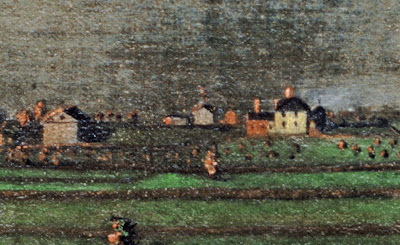Last week, a new biography of Jonathan Fisher, , by Kevin Murphy, Professor of Art History at the CUNY Graduate Center at the Metropolitan Museum of Art, and a summer resident of Brooksville, has been published by the University of Massachusetts Press. The first book about Fisher in over 40 years, it provides a fresh look at and new research about, Fisher's life and work.
Profusely illustrated, the book may be ordered from the Fisher Memorial for $49.95, plus $5.00 postage & handling. Maine residents add 5% sales tax.
Kevin Murphy was kind enough to write a few lines about the experience of writing the book and discovering Fisher:
Kevin Murphy
An Embarrassment of Riches: Researching Jonathan Fisher
Research projects often take one of two forms: extracting meaning from a small number of documents, or trying to make sense of a vast collection of materials. Writing a new biography of Jonathan Fisher has been decidedly in the latter category. There are few historical figures from eighteenth- and early nineteenth-century America—apart from presidents, famous authors, and other illuminati—for whom there is as much documentation as there is for Jonathan Fisher. As you are certainly aware, he was a indefatigable diarist, essayist, and correspondent. (Letters between Fisher and the members of his family continue to surface.) Moreover, he is that rare artist whose nearly entire known output has been located. The one exception is the numerous decorative painting projects he undertook—signs, sleighs, and so on—that were not deemed worthy of preservation.
We know a lot about Jonathan Fisher’s life, and we know a lot about what he thought we should know about it, what he considered his important contributions to be. His previous biographer, Mary Ellen Chase, for whom I have enormous respect, did a wonderful job of bringing Fisher to life and Alice Winchester, whose monograph of Fisher’s art work remains the only book of its kind, contributed much to giving us a rich portrait of the man. But they essentially focused on what Fisher considered his major contributions, that his, his religious mission, his intellectual work, and his art-making. What I wanted to do in my own work was to situate Fisher in his home and community, to show how his extraordinary undertakings—writing, painting, architectural design and so on—were part of his larger effort to make a place for himself on the eastern frontier. Although Fisher possessed a level of education that nobody else in Blue Hill did, he shared a lot with the other settlers. He was not wealthy and made his living by cobbling together a number of different jobs, much like many Mainers today. With the help of his friends, neighbors, and family, he farmed and he made things for sale locally and farther afield, in addition to drawing his minister’s salary.
While other scholars have written about Jonathan Fisher’s various undertakings, nobody has considered until now how he managed to do all of this in the space of a house that was large by the standards of the time, but hardly spacious considering there were regularly twelve or thirteen people in residence, including family and boarders. Thus I discuss how Fisher’s projects were considered in relation to the space he had to undertake them; for example, he made small watercolors in the winter months and put off doing large oil paintings until the spring, probably because he could improvise a studio in the barn or some other outbuilding. Moreover, I talk about how Fisher operated within the larger space of Blue Hill, not only interacting with a wide variety of people but also working hard to help shape the new community about which he felt so passionately. I hope that in the book I have conveyed some of my fascination for Jonathan Fisher and that it will inspire others to consider how the multi-dimensional figures of history have so much to teach us about our own quests.






















